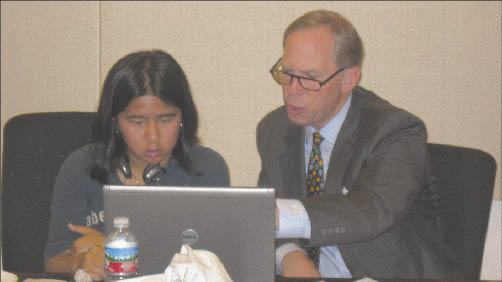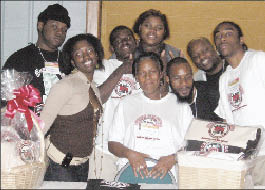When it comes to teaching youth how to make a living, the lesson almost always boils down to the same formula: Work hard for someone else. Veteran youth worker Steve Mariotti wishes more youth programs would offer kids another, potentially more powerful option: to become that someone else.
While starting a business might seem to be an option only for those from well-off families and top schools, promoters of entrepreneurship training say it can help at-risk kids build better futures by learning both business skills and crucial life skills.
 |
|
Competitive edge. Young entrepreneur Jenny Vo gets help from a mentor, Bob Higgins of Merrill Lynch, before a business plan competition run through the San Francisco affiliate of the National Foundation for Teaching Entrepreneurship.
Photo: NFTE Bay Area |
“A lot of people in poverty are not given the opportunity to think about small business as a career path,” says Mariotti, founder of the National Foundation for Teaching Entrepreneurship (NFTE), based in New York City.
While Mariotti has nothing against job training, he believes youth workers err when they stop there. “The long-term way out of poverty is to own assets,” he says.
Maybe entrepreneurship just seems too out of reach; those stories about kids who strike gold with unique (and well-funded) business ideas can be intimidating as well as inspiring. But a small industry of training programs is making entrepreneur education more systematic and more available.
“If you were to look at a graph of colleges and universities that teach entrepreneurship, you’d see that 50 years ago, it didn’t exist,” says Carrie McIndoe, senior director of the Youth Entrepreneurship Program at the National Council on Economic Education (NCEE). “Today, almost every campus has at least a class or program on the concept.” The result, she says, is a growing demand for youth to be exposed to entrepreneurship before college.
Opening Doors
The first challenge is getting time and space in classrooms, where the training typically takes place. “The biggest issue is shelf space,” Mariotti says, especially with schools so focused on standardized testing.
He says entrepreneur programs need to show school administrators research about how the programs might improve students’ performance and increase their pursuit of higher education. (See “Indicators of Success” in the NFTE and Detroit Entrepreneurship Institute profiles on the following pages.) However, most programs have no studies of their impact after youths complete them.
It also helps to have a curriculum and textbooks. That’s one benefit of affiliating with national groups, such as NFTE and Junior Achievement.
Youth entrepreneurship training suffers, however, from the lack of a national organization to serve as a resource for data, curricula and support. NCEE, which recently took over administration of the youth entrepreneurship programs previously run by the Ewing Marion Kauffman Foundation, hopes to change that. McIndoe says NCEE wants to get more teachers trained, establish the best way to evaluate the programs’ effectiveness and make sure the programs can work within each state’s standards of learning, so that teachers will have an incentive to use the programs.
The Detroit Entrepreneurship Institute (DEI) got around the problem of finding space in schools by holding a summer camp for young entrepreneurs. Most participants in the Young CEO camp are referred by social workers or youth organizations.
DEI says the camp can’t even accommodate all who want to come. “The demand is troubling,” says Shawntay Dixon, DEI’s senior director.
Opening Minds
One of the easier aspects of starting such a program also helps to open the school doors: showing support from local businesses that have committed funding or volunteer time by their employees. “Almost anyone can raise $10,000 to $15,000 [from businesses] to start a program,” Mariotti says.
Why? Many businesspeople believe it’s in their interest to help build a younger generation of businesspeople. For Nzinga Oneferua-El, founder of the Entrepreneur Training University (ETU) in Baltimore, the motive is clear: “People that are in business should be setting up young people the way drug dealers and gangs do” – that is, by teaching them the ropes early.
Getting youth excited about running businesses can be difficult in gang- and drug-ridden neighborhoods. Oneferua-El says entrepreneur training teaches young people in high-risk areas that there are options other than gangs and drugs. Mariotti stresses that in the long run, owning a small business pays better.
“There are a lot of products in the marketplace that have the same kind of mark-up that drugs do, like perfume and lingerie,” he says. “Plus, you have to analyze the cost of going into the drug industry: violence, prison, losing touch with family.”
Supporters of entrepreneur training say its benefits extend beyond learning to run a business. “We have unique insights into teaching critical thinking, math, reading and writing,” Mariotti says. “By talking about time management, budgeting and cost-benefit analysis, it empowers people.”
McIndoe says entrepreneur training also teaches kids how to recognize opportunity and evaluate risk. “We’re not necessarily trying to train them to be entrepreneurs, but how to also be good citizens and employees,” she says.
Running a Business
Entrepreneur Training University
Baltimore
(410) 235-2846
http://www.safe-inc.org
The Approach: Nzinga Oneferua-El says she started Entrepreneur Training University (ETU) two years ago in response to increasing violence in Baltimore. Located on the Lake Clifton campus of two big city high schools, ETU serves as an after-school program dedicated to teaching kids how to start and run a small business.
“We teach a lot of things here that are absent in the school system, like character development and creativity,” says Oneferua-El, who is the school program administrator at ETU and president of Student Achievers Future Entrepreneurs (SAFE), its parent organization.
ETU runs a community store on campus, staffed by students. The store sells gift baskets made by the floral design students, Street Soldier clothing, stuffed animals, balloons, snacks and jewelry.
The youths “learn inventory procedures, profit margins, customer relations and service, as well as record keeping and basic bookkeeping,” Oneferua-El says. “They also took collective responsibility in setting up the store, choosing what products to sell, store design, as well as marketing to their fellow students.”
 |
|
Gift baskets are a hot item at the store run by ETU youth.
Photo: ETU |
“The great thing I’ve seen is that entrepreneur training sparks young people,” says Oneferua-El. “The first money they make from a concept they create turns them on.”
Oneferua-El says two girls who participate in the ETU after-school program have started their own business making jewelry and selling it to friends, teachers and acquaintances. “We teach kids how to network in their own circles,” she says.
ETU also offers vocational training in floral design and silk screening. Those who complete the training get certificates that qualify them to work in those trades off campus. Many local businesspeople who sponsor and support ETU help its participating students get jobs in the city.
History and Organization: Oneferua-El says she founded SAFE in 1993 after her fiancé was murdered in Baltimore by two young people, ages 16 and 20. She says she wanted to reach out to at-risk youth by teaching them business skills and showing them there was a money-making alternative to drug dealing, gangs and violence.
She approached the principal of Dunbar High School with a plan to teach business and entrepreneurship skills to teenagers. The school gave her space to operate a school store and a place to train kids in sales and marketing, silk screening and fashion design. She later started ETU.
Youth Served: About 120 youths are enrolled in ETU’s after-school program, which serves ages 13 to 18. Oneferua-El says 65 to 80 regularly attend the program, which runs Mondays through Thursdays.
She said up to 40 percent of the youth “are receiving special needs services,” and 80 percent are on free or reduced-price lunch programs.
Staff: ETU has about 14 full- and part-time staff, as well as two students who work part-time. “The majority of our staff are parents, school personnel and people who live near the school,” Oneferua-El says.
Funding: ETU was initially funded by a matching grant of $130,000 from the Family League of Baltimore City. Today its $175,000 annual budget is provided by SAFE, by the two schools where it operates, and with $60,000 from the Community School Initiative, a local program.
Indicators of Success: Oneferua-El says ETU’s programs have undergone several outside evaluations by the likes of the University of Maryland’s School of Social Work, the After-School Institute and the Family League of Baltimore. The evaluations usually involve focus groups of parents and youths, so the findings are generally based on their opinions.
In the University of Maryland study, “The Effectiveness of Entrepreneurship Training on Youth Development,” the youths and parents rated ETU as highly effective in promoting youth development and leadership skills.
“The participants reported that the program provides a foundation for practical business application leading to entrepreneurship,” the study said. “The parents indicate that their children have shown a marked improvement in their ability to articulate themselves, resulting in positive self-esteem and open communication.”
In evaluations by the Family League of Baltimore, ETU received consistently “excellent” ratings on program quality, as rated by the youths. The study said 77 percent of ETU’s enrolled students participated in the program on a daily basis.
Learning From Executives
Junior Achievement of Georgia
Atlanta
(404) 257-1932
http://www.georgia.ja.org
The Approach: Junior Achievement (JA) focuses on teaching young people entrepreneurship skills, a global business perspective and personal finance. It recruits volunteers from local businesses to lead JA programs in area schools. Programs differ by grade level, with elementary school programs focusing on such concepts as jobs in the community and how businesses operate, and middle school programs encouraging youths to think about how their interests and skills match specific careers.
One of JA’s most popular offerings, JA Company Program, gives high schoolers a workshop on starting a company, developing a business plan, learning how to manage the companies they’ve created and learning how to write an annual report for stockholders. They also learn how to establish sales goals for products and develop a sales plan, how employee morale affects productivity, how businesses compute taxes they owe, and how dividends are paid to stockholders. The program is composed of 24 lessons delivered in eight one-hour sessions.
In another JA program, Job Shadow, youths take a four-hour field trip to a company in Atlanta, where they tour the facility and talk with employees.
 |
|
Leading: A Junior Achievement teacher before her class.
Photo: Jr. Achievement |
Rebecca Stoll, manager of volunteer operations and marketing for the Atlanta office of JA Georgia, says that familiarity with JA doesn’t necessarily make it an easy sell to teachers. “Teachers are often concerned about time, because of testing schedules they have to adhere to,” she says. On the other hand, Stoll says teachers will often report that students perform better on tests as a result of their participation in JA.
Volunteer recruitment is fairly easy, Stoll says. Many of the volunteers work for the companies that sponsor or partner with JA.
Stoll believes the most important lesson youths learn from JA is that entrepreneurship doesn’t have to be scary. “These programs take away the intimidation factor,” she explains. “Kids learn what kinds of things it takes to make a business successful.”
History and Organization: JA Georgia started in 1943 in Atlanta, just over 25 years after the national program’s founding in Springfield, Mass. All JA curricula are similar in focus, bringing trained volunteer businesspeople into the classroom to teach courses on economics and entrepreneurship in a way that’s relevant to the real world. Each of the more than 500 JA offices has its own operating budget, but all are linked with Junior Achievement Worldwide in Colorado Springs, Colo., and share the same curriculum.
Youth Served: The Atlanta JA program reports serving about 100,000 youths annually in grades K-12.
Staff: The JA in Atlanta has 20 employees and more than 4,000 volunteers, many of whom go into area classrooms to teach JA curricula.
Funding: Stoll says JA Georgia has an annual budget of $3.9 million, with most of the funding coming from such corporations as Cingular Wireless, UPS, ING and Bank of America. It also receives funding from the Hispanic Outreach Program and a small amount from JA Worldwide.
Indicators of Success: Stoll says JA uses pre- and post-program youth and teacher surveys, as well as focus groups. JA reports that on a national basis, its evaluations show that youths average a 19 percent increase in test scores after participating in classroom programs conducted by volunteers. Ninety-four percent of teachers surveyed say the JA curriculum is a valuable addition to their classroom time. Most youth participating in JA’s Job Shadow program have said they enjoyed the experience, although more than 30 percent say they would like to have more time touring workplaces and learning how they can use their education to get jobs.
Training Teachers
NFTE Bay Area
San Francisco
(415) 644-0844
http://bayarea.nfte.com
The Approach: Like all National Foundation for Teaching Entrepreneurship (NFTE) programs, this one trains local teachers in the NFTE curriculum, which they can offer in their classrooms as stand-alone lessons or incorporate into other subjects, such as history or economics.
The curriculum teaches such concepts as how to buy low and sell high, how to market products and perform market research, how to market on the Internet, and the value of philanthropy. Teachers often bring in local business leaders and entrepreneurs to discuss marketing, financial literacy and other subjects. For instance, the CEO of Snapple visited one of the NFTE classrooms in the Bay area with a case of Snapple drinks and explained how he markets his product.
Some NFTE students have visited area businesses and the trading room floor at Morgan Stanley in San Francisco.
“Teachers love the curriculum because it engages students in a new way,” says Gerald Richards, executive director of the Bay Area office. “Suddenly, kids are learning how to make a profit and how the concepts they learn in school are needed to make money. They learn they need to be good at English to write a business plan.”
Nevertheless, Richards says that getting schools to accept the program can be difficult. “The difficulty is convincing the principal of a school that it’s a great program, because they see this stuff all the time. The beauty of NFTE is we have a textbook and curriculum to show them.”
History and Organization: The Bay Area NFTE program started in 1994 with a grant from the Donner Family Foundation. It is one of hundreds of NFTE programs worldwide. NFTE was founded in 1988 by Steve Mariotti, a former import-export business owner in New York. NFTE says it has served more than 150,000 youths in 45 states and 16 countries.
Youth Served: The Bay Area NFTE serves about 1,200 youths per year in grades nine through 12. NFTE is in 18 schools in the Bay region, all of them Title I schools, where at least 40 percent of the students are on free or reduced-price lunch programs.
Staff: Three employees run the Bay Area office, while more than 30 area teachers are certified NFTE instructors. The staff provides program support for teachers and expands NFTE to more schools.
Funding: The Bay Area NFTE operates on an annual budget of $500,000. Most of its money comes from corporate and foundation donors, including the Merrill Lynch Foundation, CitiGroup, Goldman Sachs and Morgan Stanley.
Indicators of Success: The Harvard Graduate School of Education is conducting a multi-year study of NFTE’s long-term impact. NFTE says that studies conducted of the program in Boston indicate that students’ interest in college increased 32 percent while they were participating in NFTE, compared with a 17 percent increase among a control group, and that the NFTE students’ career aspirations increased by 44 percent, compared with 10 percent in the control group.
The Bay Area NFTE program surveys teachers and youth before and after the program. It says results have shown increases in youths’ math scores, interest in college and thinking about the future.
On a national level, Mariotti says, “empirically, I know about 6 to 8 percent of these kids become small business owners.”
Summer Camp
Young CEO & Investor Program
Detroit Entrepreneurship Institute
Detroit
(313) 877-9060
http://www.deibus.org
The Approach: Besides helping youths develop ideas for their own businesses and create business plan outlines, this four-week summer camp teaches leadership skills, time management, self-esteem, conflict resolution and financial literacy.
The skills are taught through workshops, including one provided by Chase bank on how to manage money. “Some of DEI’s staff are entrepreneurs, too, and some of the graduates of our adult programs talk to kids about how to run a business,” says Shawntay Dixon, senior director at the Detroit Entrepreneurship Institute (DEI).
Participants also receive training in social and business etiquette. Last year, to practice their etiquette skills, the kids played on a local golf course and ate at a formal restaurant in downtown Detroit.
At the end of the program, each youth gives a Power Point presentation about his business idea, and how he will market and price the product or service.
JUNE07_fmt.jpg) |
|
Etiquette was on the menu when DEI youth attended a formal luncheon.
Photo: DEI |
When kids graduate from the camp, Chase opens a savings account for each of them, and the Delois Whitaker Caldwall Scholarship Fund puts $200 into each child’s account, with the expectation the youths will use the money for their education or to begin working on their own business.
Because DEI can’t accommodate all the youth who want to attend, Dixon says, “We’re trying to figure out ways to take our curriculum to other sites and organizations that have youth programs.”
History and Organization: DEI began in 1990 as part of a national pilot project to help people on public assistance get out of poverty by starting small businesses. In 1996, DEI formed a nonprofit devoted to entrepreneurship training and small business assistance, which today provides services to the general public as well as to low-income people. In 1999, DEI began including youths through the Young CEO & Investor Program.
Youth Served: Each year the camp serves about 20 to 25 youths, ages 14 to 17, on a first-come, first-serve basis. While most participants come from poor areas of the city, it is open to all youth in the Detroit area.
Staff: DEI has 20 employees, several of whom help manage the summer camp. Local entrepreneurs and businesspeople volunteer their time at the camp, teaching workshops related to how to run a small business and how to save and invest money.
Funding: Dixon says the Young CEO program costs about $20,000 a year to operate, or about $1,000 per youth. It is funded by Chase bank, which also contributes volunteers, and the Delois Whitaker Caldwell Scholarship Fund.
Indicators of Success: DEI says that in surveys of participants, at least 90 percent rate the program as “very informative” in such areas as business etiquette, personal credit, business management and presentation skills. Dixon says youth alumni have started businesses in hair-braiding, tutoring, catering, Web design and desktop publishing.
Dixon says she hopes to start tracking the progress of the youth participants the way DEI tracks graduates of its adult programs, to see how many become entrepreneurs.





JUNE07_fmt.jpg)





























